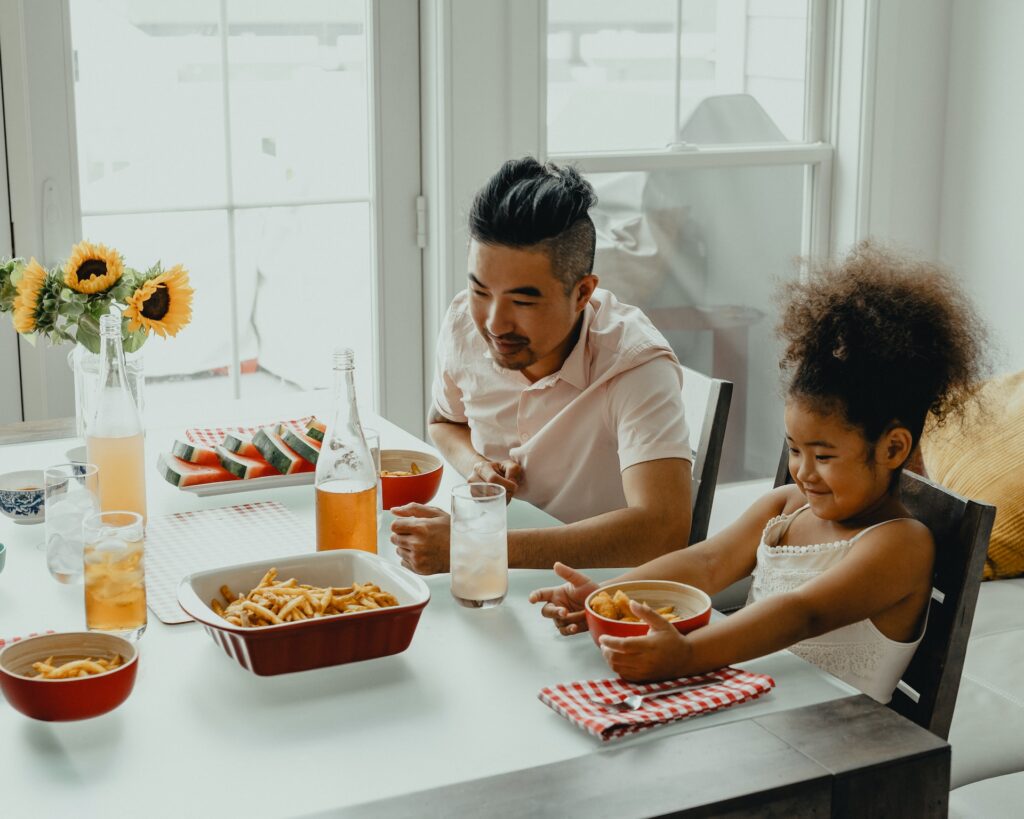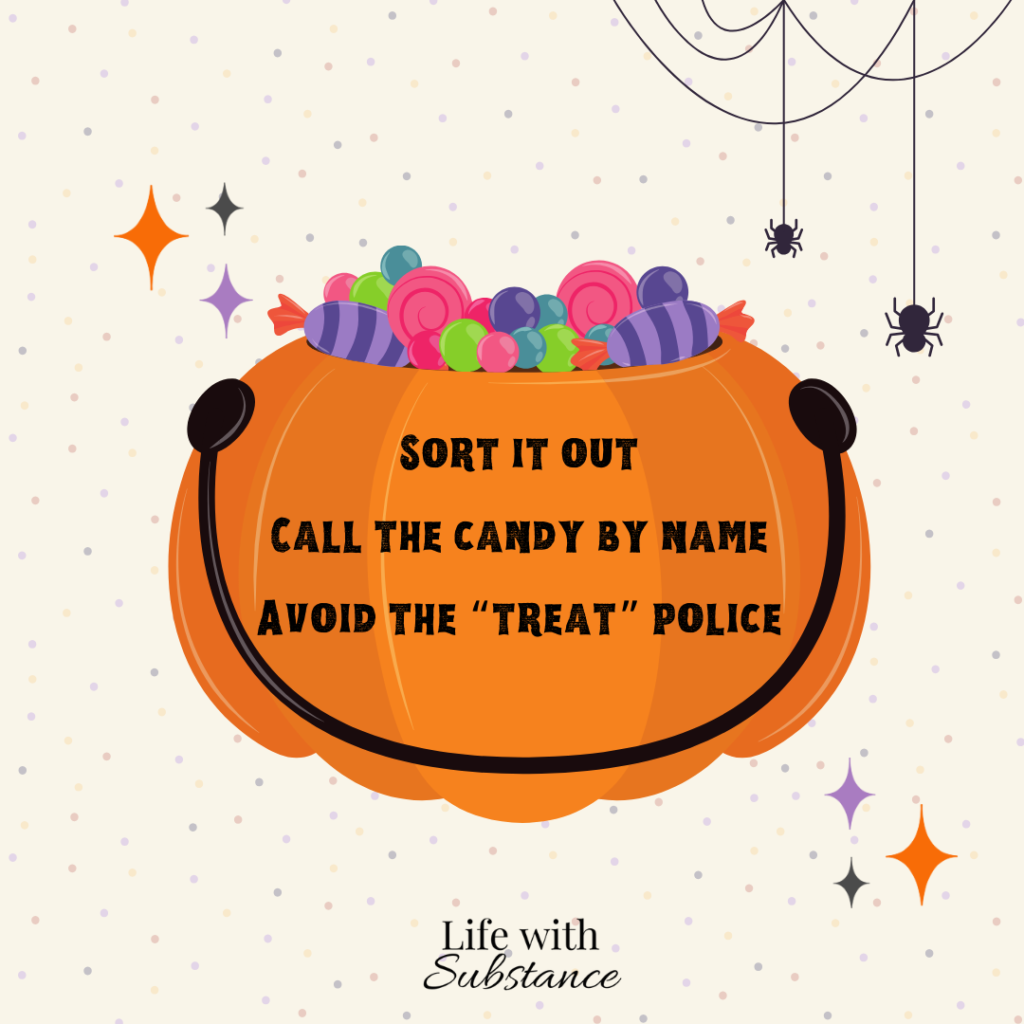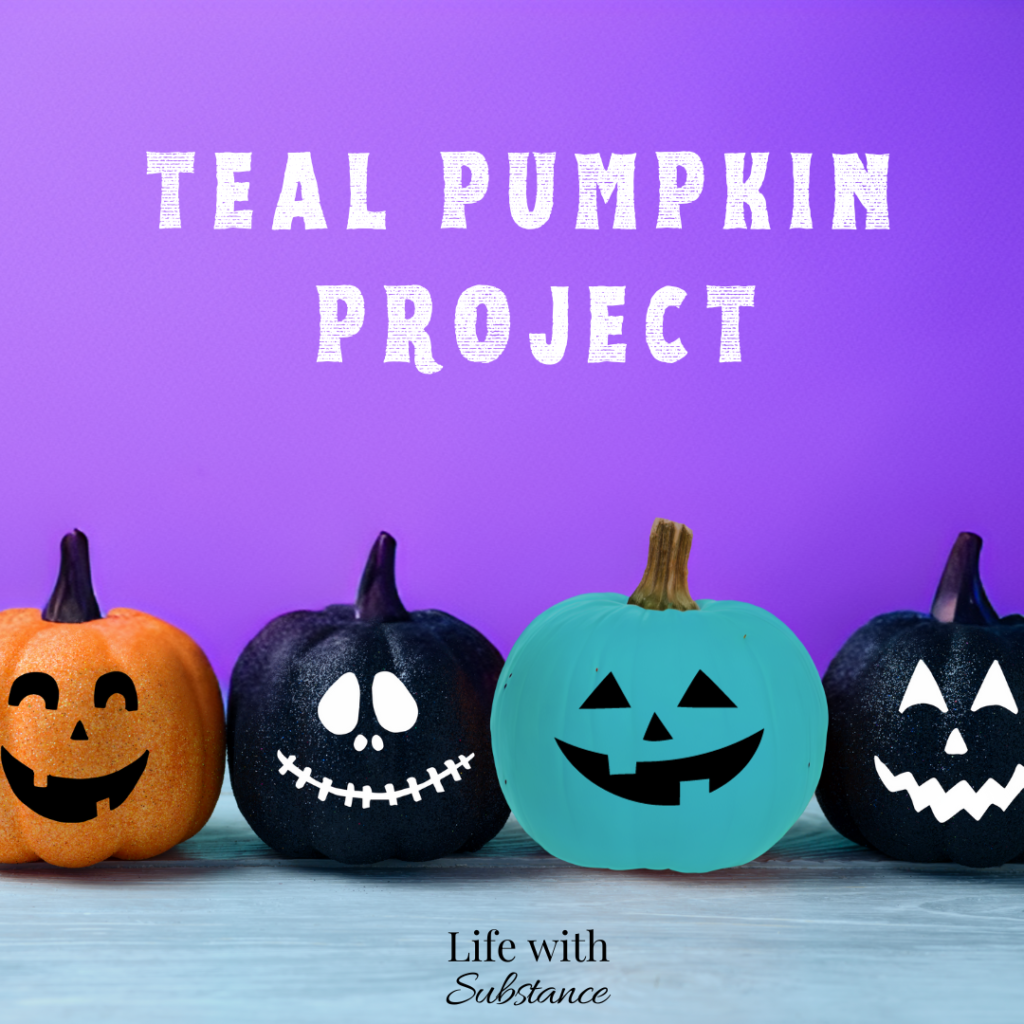This post may contain affiliate links. If you shop from one of our links, we may earn a commission.
Halloween, the spookiest and sweetest time of the year, is just around the corner. Children eagerly anticipate dressing up in costumes and, of course, the motherlode of Halloween candy they’ll collect during their trick-or-treat adventures. While it’s a favorite event for many kids, you may feel your anxiety rising as you think about navigating the excessive amount of candy.
Understanding the Halloween candy dilemma
Halloween night can be a magical and exciting time for children, filled with costumes, spooky decorations, and of course, a massive haul of candy. However, for parents, it can also be a source of stress and concern. The Halloween candy dilemma is a common struggle that many families face each year.
You may feel the need to be the “treat police”, however, this can send confusing messages to kids that can encourage an unhealthy relationship with food. As a pediatric dietitian, I understand the importance of striking a balance between allowing kids to indulge in Halloween treats and promoting a healthy relationship with food.
One of the main concerns health-conscious parents have is the sheer amount of sugar that their little ghosts and goblins consume on Halloween night. It’s no secret that candy is packed with sugar, and too much sugar can have a negative impact on children’s health. Additionally, there are concerns about choking hazards, as well as the temptation to consume the entire candy stash in one sitting. So here are some tips as you navigate Halloween candy.
On the day of Halloween
On the day of Halloween, the excitement is building as your little ones eagerly anticipate going out trick-or-treating. It’s important to have a plan in place to navigate the candy temptations that will inevitably arise. One strategy is to start the day with a nutritious and filling breakfast. Aim to include a good source of protein (meat, eggs, beans, dairy products, etc.), fat (nuts, oils, avocados, seeds, etc.), and fiber (fruits, veggies, whole grains, etc.). This will help keep your child satisfied and less likely to reach for candy throughout the day. They may still choose to overconsume candy, but that’s okay.
Prior to heading out for trick-or-treating, serve a hearty supper of foods that your kids enjoy. I like to prepare my kid’s favorite meal that evening. I know they will eat a healthy amount before heading out and be less likely to want a bunch of candy. If you don’t have time to eat beforehand, try to plan ahead by throwing a meal in the crockpot to enjoy when you get back rather than filling up with Halloween candy on an empty stomach.

On the night of Halloween
Once the trick-or-treating is done and your little ghosts and goblins are back home, you may feel an urgency to place tight restrictions on the volume of candy they can consume. Here are some tips for when you return home.
1. Sort it out
Have your kids pour out their candy and sort it into three piles: the ones they love, the ones they aren’t crazy about, and the ones they don’t like. The pile that they aren’t crazy about helps your child recognize that they can enjoy those treats if they want, but they don’t have to eat it just for the sake of eating it.
They can also consider trading candy with their siblings for something else they may enjoy more. Other fun ways to swap unwanted candy include trading it out for a small toy or non-food item, freezing it for later, or using it in baking.
2. Call the candy by name
As parents, we desire for our kids to eat a variety of nutritious foods. Some ways that we feel like we can do that is by labeling foods as “bad” or “unhealthy” in hopes of steering our kids to make wise food choices. However, labeling foods sends confusing messages to kids and can instill feelings of guilt or shame when they eat them.
Kids are also very concrete thinkers. When we place labels on food, they take it quite literally. For example, telling your child, “You should eat oranges because they are high in vitamin C and these will keep you healthy.”. Kids hear, “The only way I can stay healthy is if I eat oranges.”. The same holds true when we tell our kids foods are “good” or “bad”, “healthy” or “unhealthy”.
While some foods offer more nutritional value than others, all foods offer some value. Halloween candy provides memories, enjoyment, as well as carbohydrates. However, our kids eat more than just Halloween candy all day, every day. They are still getting variety in their diet from other food groups such as fruits, vegetables, protein, and carbohydrates.
Placing food on a pedestal only increases the desire and craving for that particular item. The point is to recognize that all foods have a place within the diet and can be enjoyed without guilt or shame.
Check out this post for more info on how to practice food neutrality.
3. Avoid being the “treat police”
Yes, your child will be overly enthusiastic about all the Halloween candy they have to choose from. With any holiday there are favorite foods that we all look forward to enjoying. For kids, this is often times candy or other sweet treats. Allow your child the opportunity to enjoy the moment. Nothing kills the joy more than suddenly having tight restrictions placed on this fun evening.
Research actually shows that when limits or restrictions are placed on certain foods, kids will actually seek these items out more. Foods that are perceived as “special” or “forbidden” are seen as a novelty and to be highly desired.
Allowing your child to enjoy as much candy as they want that night helps them recognize that these foods are all on the same playing field. Encouraging kids to try new candies can also help neutralize the treat and promote adventurous eating.

4. Promote intuitive eating with Halloween candy
Halloween can actually be an excellent opportunity to talk to our kids about mindful eating. Helping our kids recognize that they can eat in response to hunger and fullness cues is a powerful tool that will serve them well in life to have a healthy relationship with food.
As parents, we feel it is our job to micromanage our child’s food. However, when we become the food police and put tight restrictions on food this can lead to disordered eating, sneaking or hoarding food, or overeating.
Once your kids have sorted out their stash, allow them to enjoy as many pieces of candy as they want. By doing so you are helping them learn how to self-regulate. Yes, your child may overindulge and complain of a stomach ache. This is a great time for them to recognize the side effects when they eat past their internal fullness cues. Rather than punishing them or getting upset that they overate, talk to them calmly about listening to their fullness cues.
But rest assured, one night of overconsumption of candy will not affect their long-term weight or nutritional status. Intuitive eaters also eat past feeling content on occasion too.
When children are allowed to enjoy candy and other sweets freely at times and within moderation regularly, this removes the need to consume as much as possible at that moment. This can also help them better regulate when you are not present and decrease the chances of secretive eating or hoarding food.
Approaching Halloween with the mindset of intuitive eating can show your children that candy and other treats can still be enjoyed and a part of a balanced diet.
The day after Halloween
The day after Halloween is often a bittersweet time for parents and children alike. On one hand, the excitement and anticipation of Halloween night has come to an end. On the other hand, there is still a lingering reminder of the festivities: all that leftover Halloween candy.
It’s no secret that candy is a big part of Halloween. But now it’s time to figure out what to do with the large amounts of candy. As a parent, it’s important to have a plan in place to manage the candy aftermath and help your children maintain a healthy balance. Using the Satter Division of Responsibility, come up with what, when, and where the candy can be consumed.
Division of Responsibility
Kids love structure and being able to predict when they can have the candy, how much they can have, and where. By creating a plan you are also decreasing the endless requests to have candy. This also leaves ample opportunities for your child to consume plenty of nutrient-dense foods. For example, you may decide that 1-3 pieces of candy can be enjoyed at the table with lunch and supper each day.
The day after Halloween, let your children know about the dessert policy so they are fully aware of the boundaries around the Halloween candy. This plan allows your child to still enjoy their candy while encouraging a balanced diet.
Place the leftover candy in a bowl or container in the pantry or cupboard where the kids can still see it and have access to it when they are allowed to grab a couple of pieces. Allowing the candy to be in a known and visible place prevents feelings of deprivation and the need to hoard it when found. The candy jar can also be placed on the counter unless it is too much of an irresistible temptation.

The following days after Halloween
Oftentimes the excitement of all the candy wears off within a few days after Halloween has passed. The kids have fallen into a routine of what, when, and where the candy is offered and recognize that it is not held on a pedestal. Rather, candy will be available to them consistently making it less of a novelty. You may even begin to notice that your child doesn’t recognize if it was forgotten as a dessert option.
As the excitement wears off, you can begin to offer it more irregularly. If you feel overwhelmed by the large amount of candy still left, consider donating to various organizations. Or you can freeze some to offer later in the year.
Involving your kids in a plan on how to manage the excess candy prevents the sudden surprise that all of their candy was donated without their knowing. Not including them in this decision could make them want to hide candy in the future for fear of it being taken without their approval.
Setting boundaries around the dessert in the concept of the division of responsibility is one that can be applied daily. We can enjoy nutrient-dense foods while also allowing room for sweets to be part of the overall diet.
These same principles apply as you head into Thanksgiving, Christmas, and other holidays throughout the year. Helping your child recognize that sweets are not forbidden will help them to have a healthy relationship with food over time.
Healthy alternatives to Halloween candy
If you’re looking for some healthier alternatives to the traditional Halloween candy, you’re in luck! However, please recognize that there is no shame in offering candy if that’s what you prefer. If you prefer a non-candy option there are plenty of ones out there that can satisfy your little one’s sweet tooth while still providing some nutritional value. Check this video out for more fun ideas.
One idea is to opt for dried fruit snacks, such as small boxes of raisins or cranberries, which offer natural sweetness and are packed with vitamins and minerals. Offering fruit-based snacks like fruit leathers or fruit pouches is generally well-liked by many kids. Small bags of pretzels or goldfish are other fan favorites. Be aware of potential choking hazards for younger children.
Teal Pumpkin Project
Participating in the teal pumpkin project is a thoughtful way to provide options for kids with food allergies. Consider offering non-food treats, such as Halloween-themed stickers, temporary tattoos, or small toys. These alternatives can be just as exciting for kids and provide them with something fun to enjoy when they have limited candy or treat options due to their allergies.

Frequently Asked Questions
Sugar and Hyperactivity
Sugar and hyperactivity have long been linked together, especially when it comes to children. It’s a common belief that consuming excess sugar leads to hyperactive behavior in kids, especially after indulging in a big haul of Halloween candy. But is there any truth to this claim?
It may seem like your little ones are bouncing off the walls after eating a lot of sugary treats. However, scientific research does not support the idea that sugar directly causes hyperactivity. Numerous studies have found no significant difference in behavior between children who consume sugar and those who do not.
However, it’s important to note that every child is different, and some children may be more sensitive to the effects of sugar. Additionally, the excitement of Halloween and the abundance of candy may naturally lead to increased energy and excitement in children.
Ultimately, it’s up to parents to monitor their children’s behavior and use their best judgment to determine what is the best thing for them. If you notice that your child becomes overly hyper or exhibits negative behavior after consuming sugar, it may be a good idea to limit their intake or focus on healthier alternatives. However, it’s essential not to demonize sugar or create a strict “no sugar” policy. Doing so can lead to a negative relationship with food.
How much candy is too much?
It’s the age-old question that parents ask themselves every Halloween: How much candy is too much? As a dietitian, I understand the concern that many parents have about their children’s sugar intake, especially when faced with a mountain of Halloween candy. While it’s important to set limits and promote healthy habits, it’s also crucial to remember that Halloween is a special occasion, and a little indulgence is okay.
On Halloween night and the few days after they will likely eat more candy than you feel comfortable with. However, allowing them to overeat can help them recognize the volume that feels right to them. Yes, they may feel crappy from the sugar load. This is a valuable lesson for them to learn when it comes to listening to their body. They will realize they a few pieces can also be satisfying without the side effects.
When determining how much candy is too much, it’s essential to consider a few factors. First, take into account your child’s age. Kids ages 2 years and younger don’t need any candy or high-sugar foods at all. However, when older siblings are enjoying candy they are going to want some as well. Allowing them a few pieces that are not a choking hazard is fine.
Kids ages 2 to 4 years likely aren’t able to manage their candy stash. As a result, they will need assistance choosing safe options and the volume that was determined for your dessert policy. Kids ages 4+ can likely manage their stash of candy by choosing the determined amount of candy within the allowed time frames.
In Summary
Halloween is a fun holiday centered around candy that may make you as the parent feel uncomfortable. However, allowing candy decreases the novelty and helps kids have a healthy relationship with sweet treats. It’s okay for your kids to enjoy as much candy on Halloween night as they desire. This provides a great opportunity to teach intuitive eating. In the grand scheme of things, one night of overindulgence will not affect their long-term nutrition status. After Halloween, establish a dessert policy using the division of responsibility to set healthy boundaries around treats.


6 comments
So good and so helpful! Thanks!
Thank you so much! I’m glad you found it helpful!
Good post. I learn something new and challenging on blogs I stumbleupon everyday. It’s always useful to read through content from other authors and use something from their web sites.
Thanks so much for your comment! I’m glad to know you found it useful. 🙂
Appreciate this post. Let me try it out.
Thank you so much for your feedback! I hope you find it helpful.
Comments are closed.